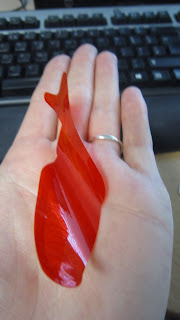Six months have passed since I started my contract as a
cataloguing archivist for the Norman Dott project and after cataloguing 4308
case notes, it is time for me to move on to another project involving medical records:
‘RVH v TB’, a project to catalogue LHSA’s Royal Victoria Hospital tuberculosis and diseases of the chest case notes and registers (c.1920-2000). I will be
working alongside Becky and later Clair to catalogue the 25,000 cases files
from the Royal Victoria Tuberculosis Trust and associated hospitals.
 |
| Boxes containing the LHB41 CC/4 series. |
Last Monday I started working on the series LHB41 CC/4,
which is composed of 71 boxes of case files from the Royal Victoria Dispensary
for Diseases, plus 6 boxes of X-ray films and 6 boxes of miscellaneous papers.
My target is to catalogue 40 case notes a day on the xml editor Oxygen. The
transition from one project to another has been facilitated by the fact that
the methodology used for cataloguing the tuberculosis (TB) case notes is based
on the one created for the Norman Dott records. They contain the same kinds of
documents, from roughly the same period: case summaries, correspondence, notes,
charts, medical reports, sometimes X-rays, and forms and contact sheets. I
record the same type of information: age, sex, geographical origin and name
of the patient, medical conditions and symptoms, date at examination,
covering dates, type of treatment given, and outcome for the patient.
However, there are some differences between the Norman Dott case notes and the TB case notes – beyond the fact that pulmonary
tuberculosis, pneumonia and bronchitis have now replaced brain aneurysms,
cerebral tumours and head injuries.
 |
| An example of case note from the TB collection. PR4.72 (all personal details have been redacted) |
One of the most important differences is the fact that tuberculosis was a highly
infectious disease, unlike most of the conditions in the Norman Dott records. The
methodology created for the Dott project has been adapted to reflect this
particularity: for example, the way locations are recorded in the RVH v TB
project is slightly different. Most patients come from Edinburgh itself, so it
was decided to use Westminster constituencies to locate the patients: it is
precise enough to give an idea of the spread of the disease without risking
disclosing the identity of an individual. We also record the family history of
tuberculosis, indicating whether a member of the patient’s family had had
tuberculosis or not. Tuberculosis was a matter of public health, and public authorities made everything in their power to stop the spread of the disease. It included keeping track of all the persons who had been in contact with an
infected patient, mainly their family but also their landlord and neighbours
when applicable. The persons deemed at risk were then called for examination; that’s
why the case files sometimes contain contact sheets detailing the examination
of the relatives of a patient suffering from TB. In these circumstances, children
were often given the BCG vaccine (that is to say the Bacillus Calmette-Guérin
vaccine, against tuberculosis).
The Royal Victoria Dispensary case notes promise to be as
fascinating as the Norman Dott records, with their own particularities and
challenges. I am looking forward to learning
more about the history of tuberculosis in Edinburgh and helping project cataloguing
archivist Becky to complete the cataloguing of this impressive collection.
Aline Brodin, project cataloguing archivist.


